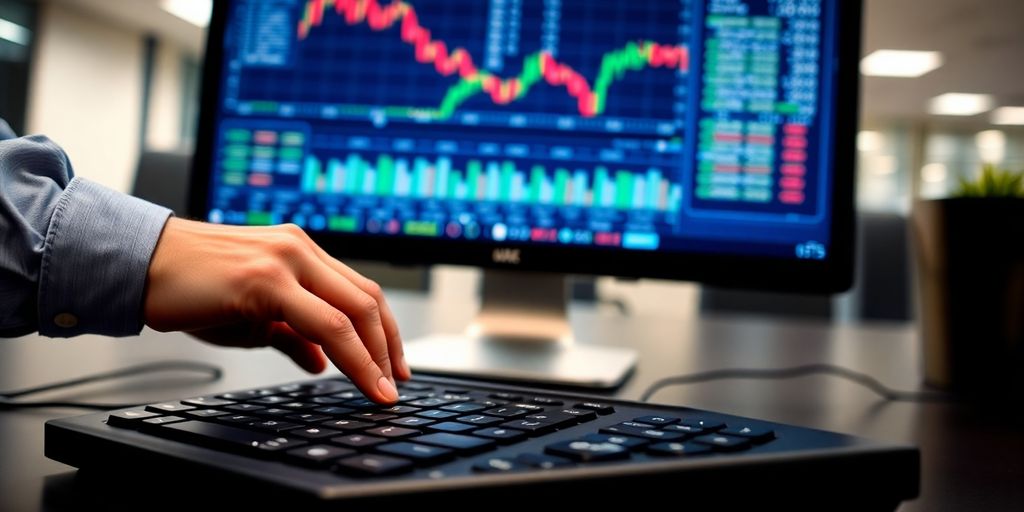So, you’re keen to jump into the Aussie share market, eh? Good on ya! Figuring out how to buy shares on the ASX might seem a bit tricky at first, like trying to understand cricket rules without a mate to explain them. But don’t stress, it’s actually pretty straightforward once you get the hang of it. This guide is gonna walk you through everything you need to know, from what the ASX even is, to picking a broker, and even some smart tips to get you started. Let’s get cracking!
Key Takeaways
- The ASX is Australia’s main stock exchange, and it’s a big player globally.
- You’ll need a broker to buy shares; make sure they can trade on the ASX.
- Understanding market hours is pretty important for placing your trades.
- You can invest in individual companies or use ETFs to get a piece of the whole market.
- Always do your homework on companies and spread your investments around a bit.
Understanding the Aussie Share Market
What is the ASX All Ordinaries Index?
The All Ordinaries, or ‘All Ords’ as some call it, is basically a snapshot of the 500 biggest companies listed on the Australian Securities Exchange (ASX). It’s the oldest index we’ve got, and while it’s not the benchmark everyone uses these days, it still gives you a broad idea of how the Aussie market is doing. Think of it as a wide-angle lens view of the market. It’s been around for ages, so it’s got a long history, but these days, most people keep a closer eye on the S&P/ASX 200.
Exploring the S&P/ASX 200
Now, the S&P/ASX 200 is the index that most investors and professionals actually watch. It tracks the performance of the top 200 companies by market capitalisation listed on the ASX. This means it represents a pretty significant chunk of the Aussie market – around 80% of the total market cap, give or take. Because it’s weighted by market cap, the bigger companies have a bigger influence on the index’s movements. So, if BHP or CSL have a good day, the S&P/ASX 200 is likely to be up, too. It’s the go-to benchmark for judging how the Aussie market is performing overall.
Key Sectors on the ASX
The ASX is home to a diverse range of sectors, each playing a vital role in the Australian economy. Here’s a quick rundown:
- Financials: Banks, insurance companies, and investment firms. Big players like the Commonwealth Bank and Westpac fall into this category.
- Materials: This includes mining giants like BHP and Rio Tinto, as well as companies involved in resources and construction materials. Australia’s a big exporter of raw materials, so this sector is pretty important.
- Healthcare: Companies like CSL and ResMed are in this sector, along with other pharmaceutical and biotech firms. It’s a growing sector as the population ages.
- Real Estate: Property developers, REITs (Real Estate Investment Trusts), and other property-related businesses.
- Consumer Discretionary: Retailers, media companies, and other businesses that rely on consumer spending. Think Harvey Norman or Wesfarmers.
Understanding these sectors and how they perform is key to diversifying your portfolio. Different sectors react differently to economic conditions, so spreading your investments across multiple sectors can help reduce risk.
Knowing which sectors are doing well, and which are struggling, can give you a leg up when you’re picking stocks. It’s all about doing your homework and understanding the bigger picture.
Navigating the ASX Trading Day
ASX Trading Hours Explained
The ASX operates with specific hours, and understanding them is key to timing your trades. The core trading session runs from 10:00 AM to 4:00 PM, Sydney time. However, there’s more to it than just those hours. Keep in mind that Sydney time is important, especially if you’re trading from another state or overseas.
The Role of Pre-Open Trading
Before the main session, there’s a pre-open phase. This period, from 7:00 AM to 10:00 AM, allows brokers to enter orders into the system. It’s like lining up at the door before the shops open. This pre-open activity helps set the stage for the day’s trading and can give you an idea of where the market might be heading. It’s a good time to keep an eye on market activity and adjust your strategy if needed.
Market Close Procedures
The end of the trading day is also structured. From 4:00 PM to 4:10 PM, brokers can adjust or cancel orders. Then, a closing single price auction takes place between 4:10 PM and 4:12 PM. This auction determines the official closing price for each security. It’s a short but important period that can sometimes lead to unexpected price movements. After this, there’s a brief system maintenance window. Here’s a quick rundown:
- 4:00 PM – 4:10 PM: Order adjustments allowed
- 4:10 PM – 4:12 PM: Closing single price auction
- 6:59 PM – 7:00 PM: System maintenance
Knowing these timings can help you plan your trades more effectively. Missing the closing auction, for example, could mean waiting until the next day to execute your order. So, keep a close watch on the clock!
Choosing Your Aussie Broker

Alright, so you’re keen to get into the Aussie share market? Good on ya! But before you start picking stocks, you’ll need a broker. Think of them as your gateway to the ASX. They’re the ones who actually buy and sell shares on your behalf. Choosing the right one can make a big difference to your investing experience, and your wallet.
Finding an ASX-Participating Broker
First things first, you need to make sure your broker can actually access the ASX. Sounds obvious, right? But not all brokers are created equal. Some might specialise in international markets, and not have direct access to the Australian Securities Exchange. An ASX-participating broker is essential for buying and selling Aussie shares directly.
Here’s a few things to consider:
- Check their ASX accreditation: Most brokers will clearly state on their website if they’re an ASX participant. If you can’t find it, ask them directly.
- Consider brokerage fees: These can vary wildly. Some brokers charge a flat fee per trade, while others charge a percentage of the trade value. Work out which structure suits your trading style.
- Look at platform features: Does the broker’s platform offer the tools and information you need? Things like charting, research reports, and real-time data can be really helpful.
Considerations for International Investors
If you’re an international investor looking to get into the Aussie market, there are a few extra things to keep in mind. Not all brokers cater to international clients, and those that do might have different requirements or fees.
- Account minimums: Some brokers might require higher minimum account balances for international investors.
- Tax implications: Make sure you understand the tax implications of investing in Australia as a foreign resident. It’s always a good idea to get professional advice.
- Currency conversion: You’ll need to convert your funds into Australian dollars to trade on the ASX. Check the broker’s forex conversion fee and exchange rates.
Setting Up Your Share Trading Account
Once you’ve chosen a broker, you’ll need to set up a share trading account. This is usually a pretty straightforward process, but it’s important to have all your ducks in a row.
- Gather your documents: You’ll typically need proof of identity (like a passport or driver’s licence) and proof of address (like a utility bill).
- Complete the application form: This will usually be done online. Be prepared to provide information about your investment experience and financial situation.
- Fund your account: Once your account is approved, you’ll need to deposit funds into it before you can start trading. Most brokers offer a range of funding options, like bank transfer or credit card.
Choosing a broker is a pretty important step, so don’t rush it. Do your research, compare your options, and pick a broker that suits your needs and investment style. Happy trading, mate!
Investing in ASX-Listed Companies

Direct Share Investment on the ASX
Alright, so you’re keen to buy shares directly on the ASX? Good on ya! It’s a pretty straightforward process, but there are a few things you need to keep in mind. First off, you can’t just rock up to the ASX and start buying shares yourself. You need a broker, someone who’s actually allowed to trade on the exchange.
- Find a broker that suits your needs (more on that later).
- Open an account and deposit some funds.
- Do your research and pick some shares you reckon will go up.
- Place your order through the broker’s platform.
Remember, investing in shares always carries risk. Don’t put all your eggs in one basket, and never invest more than you can afford to lose. It’s a marathon, not a sprint.
Understanding ASX 200 ETFs
Now, if picking individual stocks sounds like too much hard work, you might want to consider ASX 200 ETFs. An ETF, or Exchange Traded Fund, is basically a basket of shares that tracks a particular index, in this case, the S&P/ASX 200. This means you’re investing in the top 200 companies on the ASX all at once! It’s a great way to diversify your portfolio without having to buy hundreds of different shares. You can’t directly invest in the ASX 200 ETFs because it is an index, rather than a tangible asset like oil or shares.
Here’s a quick comparison:
| Feature | Direct Shares | ASX 200 ETFs |
|---|---|---|
| Diversification | Requires effort to diversify | Instant diversification across 200 companies |
| Research | Requires in-depth company analysis | Less research needed, focuses on market trends |
| Management Fees | No management fees (brokerage fees apply) | Management fees apply |
Top Companies on the ASX
So, who are the big players on the ASX? Well, you’ve probably heard of a few of them. These companies often have a large market capitalization. Here’s a quick rundown of some of the top dogs:
- BHP (BHP): One of the world’s largest mining companies. They dig up everything from iron ore to petroleum.
- Commonwealth Bank of Australia (CBA): One of the
Regulatory Oversight of the ASX
ASIC’s Role in Market Supervision
The Australian Securities and Investments Commission (ASIC) is the main regulator, keeping a close eye on the ASX. ASIC’s job is to make sure the market is fair, efficient, and transparent. They do this by monitoring trading activity, enforcing the law, and taking action against dodgy behaviour like insider trading or market manipulation. They also set rules for how companies should behave and what information they need to share with investors. Think of them as the cops of the stock market, making sure everyone plays by the rules. Public companies in Australia operate transparently thanks to ASIC.
Reserve Bank of Australia’s Influence
The Reserve Bank of Australia (RBA) also has a say in how the ASX operates, although their focus is more on the overall financial system. The RBA is interested in the stability of the financial system, and that includes the stock market. If the stock market goes belly up, it can have a big impact on the economy, so the RBA keeps an eye on things and can step in if needed. They don’t directly regulate the ASX in the same way as ASIC, but their decisions on interest rates and monetary policy can definitely affect the market.
Ensuring Market Integrity
Market integrity is all about making sure investors trust the ASX. If people don’t think the market is fair, they won’t invest, and that’s bad for everyone. Here are some ways market integrity is maintained:
- Strict rules: ASIC sets rules about how companies need to report information and how trading should be conducted.
- Monitoring: ASIC keeps a close eye on trading activity to spot anything suspicious.
- Enforcement: If someone breaks the rules, ASIC can take action, like fines or even jail time.
Market integrity is super important for a healthy stock market. It’s about making sure everyone has a fair go and that the market isn’t rigged in favour of a few.
Strategic Tips for ASX Investors
Diversifying Your Portfolio
Don’t put all your eggs in one basket, mate! Diversification is key to managing risk in the share market. Spreading your investments across different sectors and asset classes can help cushion the blow if one area takes a tumble. Think about it – if your entire portfolio is in mining stocks and the price of iron ore plummets, you’re going to feel it. But if you’ve also got some investments in healthcare, tech, or even property, you’re in a much better position. Diversification isn’t about chasing the highest returns in every single investment; it’s about building a resilient portfolio that can weather the ups and downs of the market. Consider ASX 200 ETFs for instant diversification.
- Invest in a mix of industries (e.g., finance, resources, technology).
- Consider different asset classes (e.g., shares, bonds, property).
- Explore international markets for broader exposure.
Diversification is a risk management technique, not a guarantee against losses. It aims to reduce the impact of any single investment on your overall portfolio performance.
Researching Company Fundamentals
Before you chuck your hard-earned dosh at a company, do your homework! Don’t just jump on the bandwagon because your mate told you it’s the next big thing. Dig into the company’s financials, understand its business model, and assess its competitive position. Look at things like revenue, profit margins, debt levels, and cash flow. Read the annual reports, listen to investor presentations, and keep an eye on industry news. A bit of research can go a long way in helping you make informed investment decisions. It’s about understanding the true value of a company, not just relying on hype or speculation. You can also look at smart investing strategies.
Staying Informed on Market News
The share market is a dynamic beast, and things can change quickly. Staying informed about market news and trends is crucial for making smart investment decisions. Keep an eye on economic indicators, interest rate movements, and global events that could impact the Aussie market. Read reputable financial news sources, follow market analysts, and attend industry events. The more you know, the better equipped you’ll be to react to market changes and make informed decisions about your portfolio. Remember, knowledge is power, especially when it comes to investing. Being informed helps you make timely adjustments to your investment strategy.
The Global Significance of the ASX
The ASX isn’t just about Aussie shares; it’s a player on the world stage. Its unique position and accessibility make it important for global investors and markets.
ASX’s Position in Global Markets
The Australian Securities Exchange (ASX) is among the top exchanges globally by market capitalisation. It lists over 2,000 companies and has a market cap of over $1 trillion AUD. This size puts it in the big leagues with exchanges like the NYSE and NASDAQ. The ASX offers trading in various asset classes, including equities, fixed income, and commodities and energy.
Time Zone Advantages for Trading
One of the ASX’s key advantages is its time zone. Sydney is ahead of major financial centres like New York and London. This means the ASX is the first major exchange to open each day, setting the tone for global trading. Local time in Sydney is 15 hours ahead of New York time, seven hours ahead of London time and three hours ahead of Hong Kong time. This allows investors in Asia and Europe to react to overnight news and events before their own markets open. It’s a bit like getting a sneak peek at the day’s trading action.
Accessibility for Foreign Investors
The ASX is pretty accessible for foreign investors. While you can’t just rock up and trade directly, you can do it through a broker that’s an ASX participant. Many international brokers offer access to the ASX, making it relatively easy to buy and sell Aussie shares. Plus, there are exchange-traded funds (ETFs) listed on US exchanges that track ASX-based indexes, providing another way for American investors to get involved.
The ASX has come a long way since its beginnings in the 1870s. It merged with the Sydney Futures Exchange in 2006, creating a modern exchange that uses technology like blockchain for clearing and settlement. It plays a big role in Australia’s economy and is connected to the global financial system.
Wrapping It Up: Your ASX Journey
So, there you have it, folks. Getting into shares on the ASX might seem a bit much at first, but it’s totally doable. We’ve gone through the basics, from picking a broker to understanding what makes a company worth looking at. Remember, it’s not about getting rich overnight; it’s more about playing the long game and making smart choices. Do your homework, don’t just jump in, and always be ready to learn. The market can be a bit wild sometimes, but with a bit of patience and a good plan, you’ll be on your way. Good luck out there, and happy investing!
Frequently Asked Questions
What’s the go with the ASX All Ordinaries Index?
The ASX All Ordinaries Index is like a big scorecard for the Australian share market. It tracks the share prices of the 500 biggest companies listed on the ASX. So, if the All Ords is going up, it generally means a lot of big Aussie companies are doing well.
And what about the S&P/ASX 200?
The S&P/ASX 200 is another important index, but it’s a bit more focused. It looks at the 200 largest companies on the ASX, based on their market value. Many folks use it as a key indicator of how the top end of the Aussie market is performing.
When can I actually buy and sell shares on the ASX?
The ASX is open for normal trading from 10 am to 4 pm Sydney time, Monday to Friday. But there’s a ‘pre-open’ session from 7 am, where brokers can get their orders ready, and a short ‘market close’ period after 4 pm to finalise things.
Can I invest directly in the ASX 200?
You can’t directly buy the ASX 200 itself because it’s just a number, not a company. But you can invest in ‘Exchange Traded Funds’ (ETFs) that track the ASX 200. These ETFs hold shares in all the companies that make up the index, so you get a piece of the whole lot.
Who looks after the ASX to make sure it’s fair?
The Australian Securities and Investments Commission (ASIC) is the main watchdog for the ASX. They make sure everyone plays fair and that the market is honest and transparent. The Reserve Bank of Australia also keeps an eye on the overall financial system to make sure it’s stable.
Can people from other countries invest in the ASX?
Yep, you sure can! But you’ll need to open a trading account with a broker that has permission to trade on the ASX. Not all international brokers can do this, so it’s worth checking first.





